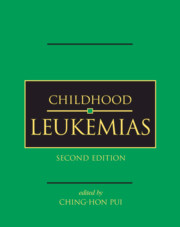Book contents
- Frontmatter
- Contents
- List of contributors
- Preface
- Part I History and general issues
- Part II Cell biology and pathobiology
- Part III Evaluation and treatment
- 14 Pharmacokinetic, pharmacodynamic, and pharmacogenetic considerations
- 15 Assays and molecular determinants of cellular drug resistance
- 16 Acute lymphoblastic leukemia
- 17 Relapsed acute lymphoblastic leukemia
- 18 B-cell acute lymphoblastic leukemia and Burkitt lymphoma
- 19 Acute myeloid leukemia
- 20 Relapsed acute myeloid leukemia
- 21 Myelodysplastic syndrome
- 22 Chronic myeloproliferative disorders
- 23 Hematopoietic stem cell transplantation
- 24 Acute leukemia in countries with limited resources
- 25 Antibody-targeted therapy
- 26 Adoptive cellular immunotherapy
- 27 Gene transfer: methods and applications
- 28 Minimal residual disease
- Part IV Complications and supportive care
- Index
- Plate Section between pages 400 and 401
- References
24 - Acute leukemia in countries with limited resources
from Part III - Evaluation and treatment
Published online by Cambridge University Press: 01 July 2010
- Frontmatter
- Contents
- List of contributors
- Preface
- Part I History and general issues
- Part II Cell biology and pathobiology
- Part III Evaluation and treatment
- 14 Pharmacokinetic, pharmacodynamic, and pharmacogenetic considerations
- 15 Assays and molecular determinants of cellular drug resistance
- 16 Acute lymphoblastic leukemia
- 17 Relapsed acute lymphoblastic leukemia
- 18 B-cell acute lymphoblastic leukemia and Burkitt lymphoma
- 19 Acute myeloid leukemia
- 20 Relapsed acute myeloid leukemia
- 21 Myelodysplastic syndrome
- 22 Chronic myeloproliferative disorders
- 23 Hematopoietic stem cell transplantation
- 24 Acute leukemia in countries with limited resources
- 25 Antibody-targeted therapy
- 26 Adoptive cellular immunotherapy
- 27 Gene transfer: methods and applications
- 28 Minimal residual disease
- Part IV Complications and supportive care
- Index
- Plate Section between pages 400 and 401
- References
Summary
Introduction
Complex interactions between genetic and environmental factors underlie the etiologies of pediatric leukemias and lymphomas. Thus, it is not surprising that the incidence rates for these disorders vary widely across geographic regions (Table 24.1). In contrast to the wealth of etiologic and epidemiologic data on pediatric cancers in the United States, comparable information is not available for most countries (which lack population-based registries and adequate diagnostic methods); for that reason, only marked discrepancies in cancer incidence can be noted among regions. For example, non-Hodgkin lymphoma (NHL) of the mature B-cell immunophenotype (Burkitt lymphoma) is the most common malignancy in many African countries. Environmental factors, including infectious agents such as Epstein–Barr virus and malaria (highly prevalent in these regions), appear to contribute to the etiology of this disease. The high relative incidence of Burkitt lymphoma in these regions is even more remarkable in view of the generally lower incidence of acute lymphoblastic leukemia (ALL) in blacks compared to whites. Other examples include an increased incidence of Kaposi sarcoma in children in regions with a high rate of endemic HIV infection, of acute promyelocytic leukemia in people of Italian or Hispanic heritage, of acute myeloid leukemia (AML) presenting with chloroma in Turkey, and of T-cell ALL in children from India and Egypt. Given these empiric observations on a limited number of countries, it is not surprising that the distribution of pediatric cancers shows substantial variation across the world's regions.
- Type
- Chapter
- Information
- Childhood Leukemias , pp. 625 - 638Publisher: Cambridge University PressPrint publication year: 2006



